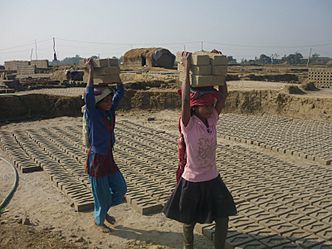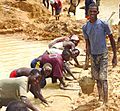Child labour facts for kids


Laws on child labour, the Factory Acts, were passed in Britain in the 19th century. Children younger than nine were not allowed to work, those aged 9–16 could work 16 hours per day: Cotton Mills Act. In 1856, the law permitted child labour past age 9, for 60 hours per week, night or day. In 1901, the child labour age was raised to 12.
Child labour means that children are forced to work like adults and take part in an economic activity. According to the ILO International Labour Organization this is applied to people up to age fifteen, or seventeen in case of dangerous work. Even though only about a fourth of the ILO members have ratified the respective convention, this age limit is generally accepted.
Child labour refers to the employment of children in any work that deprives children of their childhood, interferes with their ability to attend regular school, and that is mentally, physically, socially or morally dangerous and harmful.
Child labour is fundamentally different from casual work done by children, like guarding other children, or helping here and there. Child labour is forbidden in most countries. These days we see many minor boys and girls working in tea stalls, restaurants, hotels and other small shops. Some work in huge factories like brick factories. This is caused due to child labour, and the main reason why child labour occurs is poverty.
There are two kinds of work that minors can do:
- Some work they do is acceptable, as it is only light, or easy to do. Children can also do it while they are well-integrated into the family. This kind of work can be done in addition to an education the children are getting.
- The other kind of work is difficult to do, or it is physically exhausting. It may be dangerous, the children may be required to work for long hours and in humiliating clothing.
There are many prejudices against child labor in the Western world: Very often such cases are known through scandals made by the mass media: In that manner, a working child is often seen as a slave, working in a sweat shop in a third world country, producing textiles, or as one of the street children in South America. The reality is different though: Such shops exist all over the world, also in countries like the United States or Italy. The fact that child labour is involved is often hidden: More than three quarters of this work is done in the sector of agriculture, or it has to do with activities done at home, in the context of the family. If child-slaves exist, they are only a minority. This form of work done by children also existed before industrialisation and globalisation, the two phenomena have made it more visible, at best.
Related pages
Images for kids
-
A boy repairing a tire in Gambia
-
Young girl working on a loom in Aït Benhaddou, Morocco, in May 2008
-
Agriculture deploys 70% of the world's child labour. Above, child worker on a rice farm in Vietnam.
-
Child labour in a quarry, Ecuador
-
Young street vendors in Benin
-
Missouri Governor Joseph W. Folk inspecting child laborers in 1906 in an image drawn by journalist Marguerite Martyn
-
Nepali girls working in brick factory
-
Children engaged in diamond mining in Sierra Leone
-
Working child in Ooty, India
-
Child labour in a coal mine, United States, c. 1912. Photograph by Lewis Hine.
-
Different forms of child labour in Central America, 1999
-
Child labourers, Macon, Georgia, 1909
-
Two girls protesting child labour (by calling it child slavery) in the 1909 New York City Labor Day parade.
-
Arthur Rothstein, Child Labor, Cranberry Bog, 1939. Brooklyn Museum
See also
 In Spanish: Explotación infantil para niños
In Spanish: Explotación infantil para niños




























